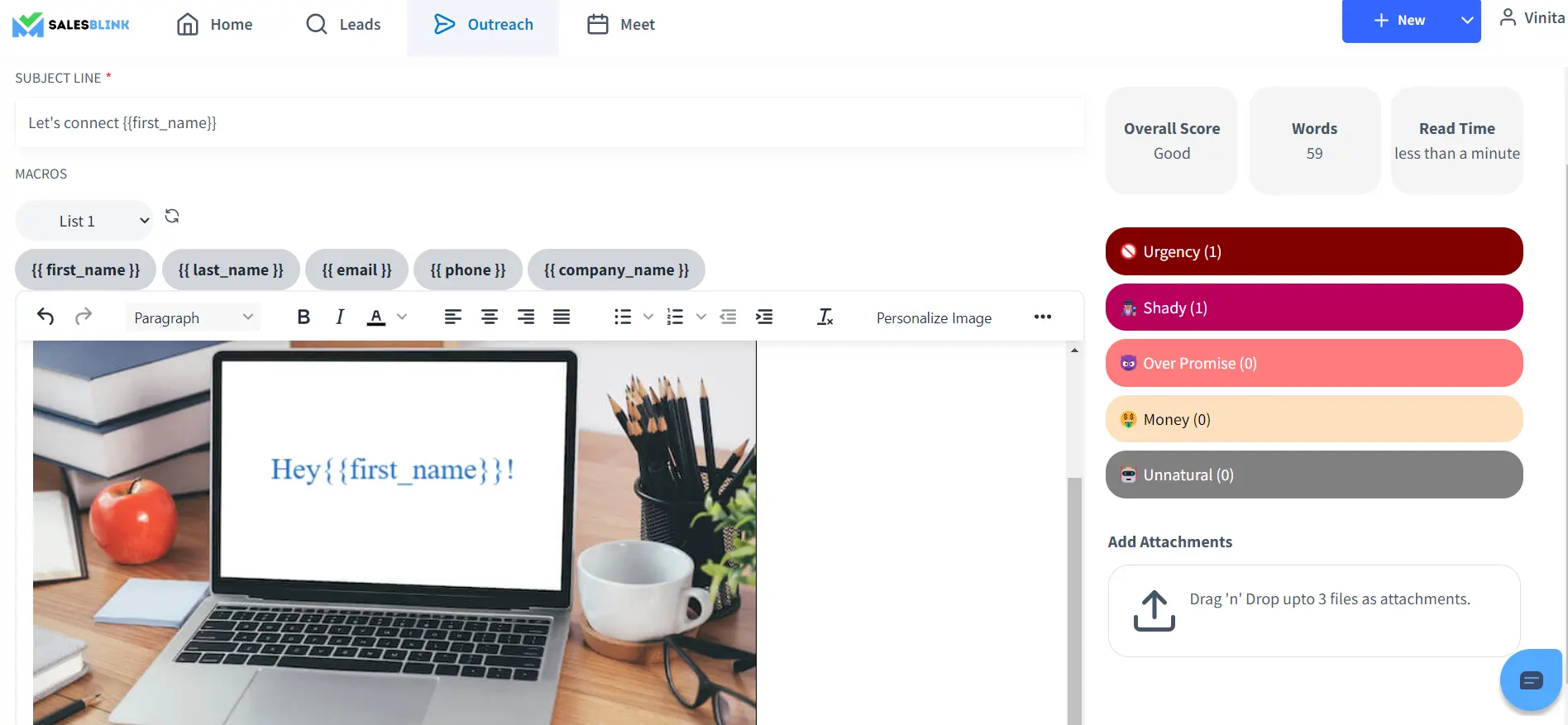How To Add Image Personalization In Cold Email Campaigns?
In the competitive world of email marketing, capturing your audience’s attention is more challenging than ever.
However, image personalization is the innovative approach you’ve been searching for. By customizing visual content for each recipient, you’ll not only grab their attention, but also pique their interest, making them more likely to engage with your email. In fact, personalized emails have to deliver 6x higher transaction rates (Experian, 2021).
Therefore, it’s time to elevate your cold email campaigns with image personalization!
This blog post will provide you with the knowledge necessary to implement this game-changing tactic, ensuring you get the attention and results you deserve. So, let’s dive into the world of image personalization and transform your cold email strategy today!
Table Of Contents
What Should You Do To Get Prospect’s Attention?
One way of drawing prospects to your email is by personalizing the email starting at the subject line. You can also use SalesBlink’s Free cold email Subject line generator tool.
Personalization improves engagement and conversion rate and helps build better customer relationships. That would go a long way in working in your favor for upselling. Unless you have a strong bond with customers, you can’t expect them to linger around for too long. Personalization is one way that lets you build that relationship with prospects/customers.
Using the first name of the prospect is a common personalization tactic. However, the inboxes of people are so cluttered with automated emails that personalizing them with the {{firstName}} tag in the mail copy or subject line doesn’t seem to work anymore. Recipients don’t seem to bother about seeing their names in subject lines. They are now immune to this kind of approach.
So, you have to think of something more motivating, otherwise, prospects are more likely to delete your emails without even opening them. After putting in so much effort in crafting emails, you wouldn’t want them to end in the trash folder, right?
What Data You Need To Personalize Emails?
The data needed for personalization is different for B2C emails and B2B emails. In the case of B2B, you would want the following:
- Name of the prospect
- Where they are located
- Purchase history
- Demographic details
- Behavioral details
- Climatic conditions
On the other hand, for B2B cold emails, there is no need for demographic and behavioral data. Following is what you should focus on instead,
- Website of the prospect’s company
- Prospect’s Industry
- Company’s annual revenue
- Company size
- Location
- Prospect’s stage in the sale cycle
Therefore, if you are into B2B sales, you have to gather relevant information and personalize it to have a higher chance of hitting the bull’s eye.
Different Ways To Personalize Cold Emails
Recipients will notice your email only when it is different from the rest. Using a human approach is the key to standing out in the crowd of emails. Just using the {{firstName}} tag is insufficient these days. So, what can be done apart from using the prospect’s name in the subject line of the email and email body? Here’s how to personalize cold emails,
1. Give a compliment

You have to personalize your email in different ways. One way out is by also searching for an article written by the prospect and writing a cold email complimenting the piece. In this age of LinkedIn, it is not difficult to find the content written by a prospect in concern. Everyone likes being complimented, and it will also increase the chances of the prospect showing interest in you. It is an opportunity to build a relationship with the person.
2. Find a common interest or similarity

If you happen to belong to the same city as your prospect, you must highlight the fact. We, as humans, tend to trust those more with whom we have something in common. The prospect will feel delighted to know that you are from his hometown, and you will get a common ground to start the conversation. You can check the prospect’s profile to gather information and see what all you have in common.
3. Point out a mutual contact

A personal recommendation from a friend or colleague is more powerful than getting a message from a business. You will trust the recommendation of a friend more than the sales pitch. Cold emails without mutual contact in between are more likely to be ignored. If you mention in the email to the prospect that you got their contact from their colleague, they are more likely to sit up and listen.
4. Mention the software currently used

Take personalization to the next level by finding out which software the prospect’s company is using. There are many tools to help you find out the list of software used from the prospect’s website. It will help you get an idea of the prospects’ requirements and whether the software they use is similar to yours. If the prospect is using your rival’s products or services, you can make changes in your email. Highlight how your products and services are better. By mentioning that your product is similar to their existing software, they will feel familiar with your offering and be less reluctant to try it out.
While there are many more ways to personalize your cold emails, you must choose the off-beat and trending one. So, which is the personalization method that will give you maximum results? The answer to that would be image personalization. It is all about making the email revolve around the prospect so that it grabs their attention.
Benefits Of Image Personalization
By using image personalization in cold email, you can get better response rates. Using visual representations such as images and videos doesn’t go unnoticed and is worth trying. They are bound to leave an impact on the prospects. Here is why using personalized images for email campaigns is powerful,
1. Helps in better communication

It is easier to communicate with visuals. In the brain, 90% of the information transmitted is visual. Our brains process images 60,000 times faster than text. It means that prospects can understand your point faster with images. With text, it can take longer, and most people are not interested in reading it.
Another interesting fact is that people remember 80% of what they see and only 20% of what they read. That means it will be easier to send the message across with images. That gives images an edge over text. Hence, you can make your cold emails more engaging by personalizing images.
2. Offers a human touch

Emails don’t have a personal touch to offer and can never replace the warmth of a face-to-face meeting. Even after personalization, it is not quite close to what an in-person meeting can do. By using visual personalization, you are adding another level of customization to your campaign. They make the prospect feel that the email is exclusively for them, and as a result, they will take interest.
3. Grabs attention

Grabbing the attention of prospects is the main focus of cold emailing. You have to get the prospect to read the email and give you a response. Unless your content is not catchy enough, you cannot expect that to happen. With personalization of images, you can succeed in engaging the prospects and even get a reply from them.
4. Builds relationships

Another advantage of personalizing images is that prospects build a bond with the sender when they feel important. It is this bond or relationship that is crucial for B2B sales. Not only will it help close a deal but also ensure future upsells and repeat business. However, this happens over time.
How To Do Image Personalization For Cold Emails?
Now, it is a tedious task to sit down and personalize an image for every email you send. As a sales rep, this is neither humanly possible nor feasible.
To help you out, you require a tool to personalize images that can generate cold email personalized images. Moreover, you need the correct data as well. In B2B sales, you have to work with details like website, industry, company size, location, annual revenue, etc.
SalesBlink
SalesBlink is an automated cold outreach tool and one of the best image personalization software around. You are free to insert macros to images using the tool. It is relatively easy to do it, and you won’t even require technical expertise.
Image Personalization

To create a personalized image in the email editor, you have to click on ‘Personalize Image’ on the email editor’s menu.
You can upload an image or select one from the options you see. Add text to it along with a macro.
For example, you can write something like the following as the image text,
Hey{{first_name}}!
Here, the variable is the name of the prospect.
You can save this template and use it for your email sequences.
The logic is that when people see their names in images; it triggers a chemical reaction in the brain, and they are more likely to pay heed to what is in front of them.
However, you need not limit yourself to using a name when you personalize images.
You can pleasantly surprise the prospect by using other variables, too, such as their company’s name. You can use your creativity because, with image personalization, there are no rigid rules to follow.
Start Leveraging Image Personalization
Personalized cold emails get more clicks and open as the recipient is more drawn to them. A recipient would feel that you have done your homework before reaching out to them. There are many different personalization tactics, such as using the recipient’s name in the email, referring to a mutual connection, or a common interest.
Image personalization in cold emails is the new kid on the block that can help you get the desired outcome from your email campaigns. As you read above, to personalize images at scale, you would need the help of an email personalization tool like SalesBlink as it is not feasible to work on images individually for every prospect.
Hope you know how to leverage image personalization.
You can thank us once you start seeing results.
FAQs
When you personalize images, you can get better response rates. Using visual representations such as images and videos doesn’t go unnoticed and is worth trying.
One way of drawing prospects to your email is by personalizing the email. It improves engagement and conversion rate and helps build better relationships. That would go a long way in working in your favor.
By using visual personalization, you are adding another level of customization to your campaign. They make the prospect feel that the email is exclusively for them, and as a result, they will take interest.







